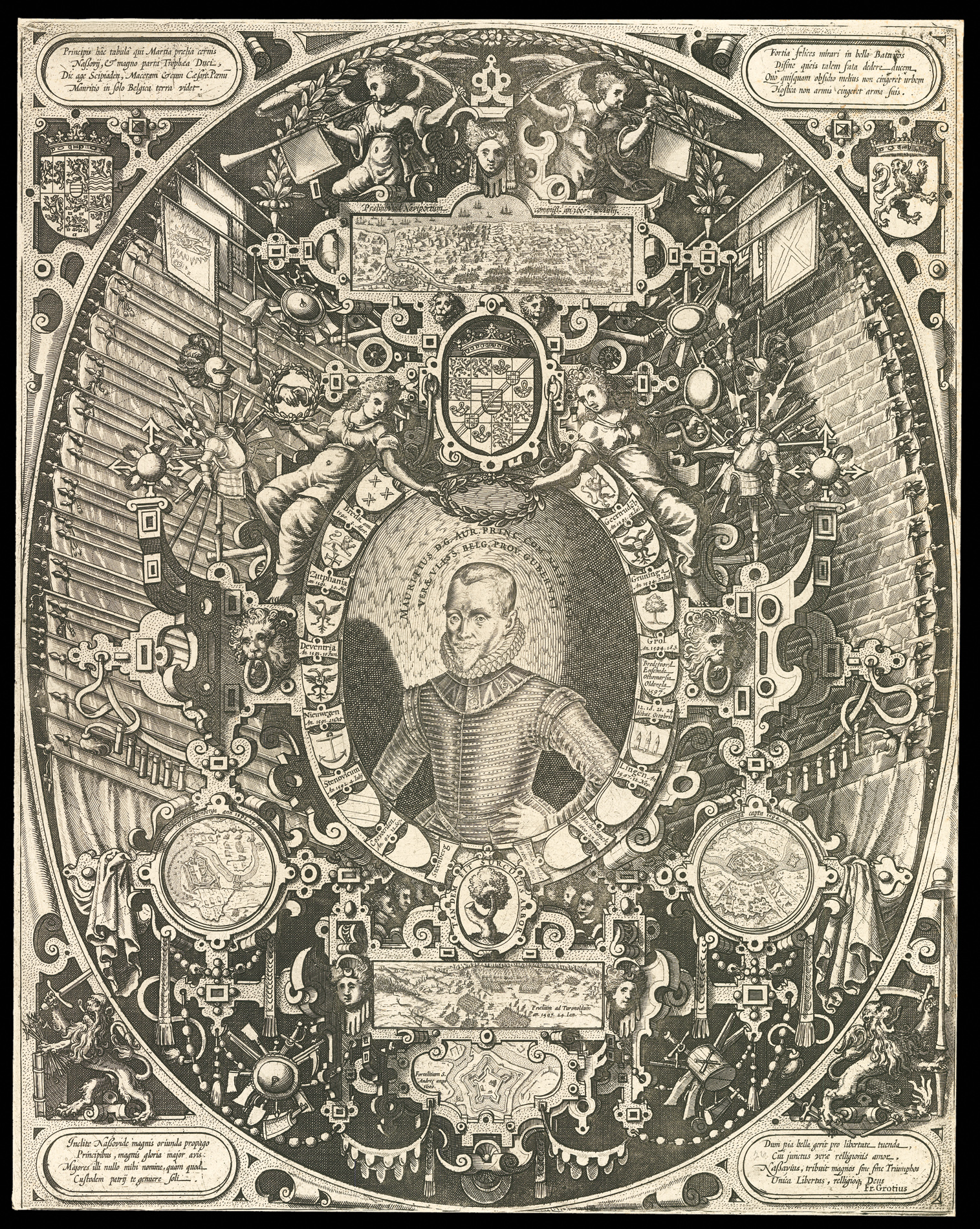
[PORTRAIT]. [Engraved portrait of Prince Maurits of Nassau].
- 出版地: [The Netherlands
- 发布日期: c.1605].
- 物理描述: Engraving with etching. Good condition, corners strengthened.
- 方面: 45 by 35.5mm. (1.75 by 1.5 inches).
- 库存参考: 2261
笔记
Beautiful and rare portrait of Prince Maurits of Orange (1567-1625), after the assassination of his father William the Silent, stadholder of the United provinces of the Dutch Republic. The portrait is half-length and Maurits, bearded and wearing a ruff collar (millstone collar), is looking to the left.
The oval portrait is probably derived from the painted portrait of Maurits by Daniël Van den Queborn and is surrounded by a monumental cartouche, celebrating Maurits’s feats of arms .
The portrait itself measures 142 by 112mm., with an engraved caption around his head: ‘Mauritius D.G. Aur. Princ Com. Nass. Mar. Verae Uliss. Belg. Prov. Gubernat.’. Above the portrait appears Maurits’s coat-of-arms, and at the bottom is his emblem, a tree trunck with two branches, one of which with a leafy crest, surrounded by his motto ‘Tamdem fit surculus arbor’ (a shoot at length becomes a tree). The border of the portrait consist of the coat-of-arms of the cities Maurits has conquered during his successful military campaigns between the years 1590 and 1600: (left) Breda (3 March 1590); Zutphen (30 May 1591), Deventer (10 June 1591), Nijmegen (21 October 1591), Steenwijk (4 July 1592), Coevorde (12 September 1592) and Steemberg (no date, coat-of-arms empty); (right) Geertruidenberg (25 July 1593), Groningen (22 July 1594), Grol (Groenlo; 28 September 1594 (=1597!)), Bredevoort, Enschede, Ootmarsum and Oldenzaal (names of the towns engraved in one coat-of-arms; 18-24 October 1597), Lingen (12 November 1597), Wachtendonck (coat-of-arms empty, 27 January 1600), and Fortalitium St. Andreae (coat-of-arms empty, 10 May 1600).
The second, much wider border (105 mm) shows a multitude of Renaissance strap work and suit of armor against a background of captured flags. Two women (Concordia and Discordia), leaning on the first border of coat-of-arms, are holding a laurel wreath above Maurits head. Furthermore there are two bird-eye’s views in rectangular frames of (1) Maurits’s most famous battle, the battle of Nieuwpoort (2 July 1600) at the top, and (2) his successful battle near Turnhout (24 January 1597), with which Maurits started his campaign in 1597 in an unexpected way, i.e. in the middle of the winter, underneath the emblem. Left, right and at the bottom there are three plans in a circular frame of Geertruidenberg (25 July 1593), Groningen (1594), and the Fortalitium S. Andreae (1600).
In the four corners are the emblems and coat-of-arms of the Dutch Republic and 4 x 4 Latin verses (tetrasticha) written by Frans de Groot (1586-1604), the younger brother of Hugo Grotius (1583-1645), in honour of the exploits of the Dutch army under the command of Maurits, especially also on the success of the battle of Nieuwpoort. These verses are probably written at the instigation of his elder brother Hugo who often supplied engravers and printers with laudatory poems at that time (Eyffinger).
参考书目
- V. Someren, p. 17, nr. 195 (dated "[1608]")
- Nijland I, p. 11, nr. 93
- A. Eyffinger, Inventory of the poetry of Hugo Grotius (1982), pp. 93 and 97
- K. Zandvliet (ed.), Maurits van Oranje (Exhib. Cat. Rijksmuseum, Amsterdam). Zwolle 2000, p. 96 (full-page illustr. on p. 97), 152.
 地图
地图  地图集
地图集  珍本
珍本  版画
版画  天文仪器
天文仪器 










